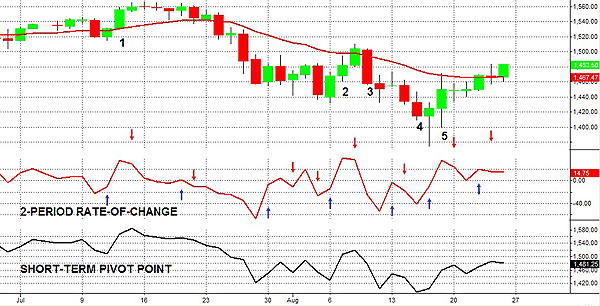
HOT TOPICS LIST
- MACD
- Fibonacci
- RSI
- Gann
- ADXR
- Stochastics
- Volume
- Triangles
- Futures
- Cycles
- Volatility
- ZIGZAG
- MESA
- Retracement
- Aroon
INDICATORS LIST
LIST OF TOPICS
PRINT THIS ARTICLE
by Paolo Pezzutti
A short-term methodology to identify buy and sell-short setups.
Position: N/A
Paolo Pezzutti
Author of the book "Trading the US Markets - A Comprehensive Guide to US Markets for International Traders and Investors" - Harriman House (July 2008)
PRINT THIS ARTICLE
RATE OF CHANGE
The Two-Period Rate Of Change
08/27/07 11:16:59 AMby Paolo Pezzutti
A short-term methodology to identify buy and sell-short setups.
Position: N/A
| Linda Bradford Ratschke and Laurence Connors introduced in Street Smarts the two-period rate of change (ROC). It was inspired by George Douglas Taylor, who in the 1940s wrote the Taylor Book Method. In his work, Taylor sets down a method for determining the short-term trend, through counting of cycle days, to form the basis for determining whether to buy, sell, or sell short. He sustained that markets tend to make swings every two to three days, alternating buying and selling pressure. Raschke and Connors focused on defining a buy setup to enter a position after a two- to three-day selloff. Similarly, they established a sell-short setup. |
| The buy day should open on its low, testing the previous day's low, and close on its high. The exit should occur some time the next day above the day's entry high, leveraging on a follow-through move. You could also decide to carry it overnight as winning trades normally provide you with the possibility to find a better exit price the next day. The opposite is true for sell-short trades. The authors suggest the use of a two-period rate of change to spot entry setups. It is built by subtracting the close of two days ago from the close of today. When it changes direction -- from down to up -- it gives you the indication to enter your position (in this case, go long) by the close, looking to close the trade the next day. |
| To further provide a reference price to guide your trading decisions, a short-term pivot point is identified. It indicates the price at which the two-period rate of change will change direction and activate your setup. It is built summing the two-period rate of change to yesterday's close. For example, suppose that the two-period ROC is up and the short-term pivot value for the emini S&P contract is 1480. It means that the indicator will change direction (from up to down) if the close will be below 1480, giving you a sell-short indication. |

|
| FIGURE 1: S&P EMINI CONTRACT. Note how the methodology had some losses, but also some very good trades (indicated by the numbers from 1 to 5). Although it cannot be applied mechanically, the methodology provides a useful guide on the short-tem market action. |
| Graphic provided by: TradeStation. |
| |
| If you look at the emini S&P action of the past weeks in Figure 1, you can see the methodology at work. Normally, you have small losers and small winners. Sometimes you will be able to catch a big fish. The market has experienced a fast directional move that is not ideal for trading swings. You can see that there have been several small losses. However, there have been five really good trades that provided very good gains with expansion days in the direction of the trade. It is on these good trades that you can base your performance. In particular, trade 1 from close to close has a 24.75-point gain, trade 2 14.75, trade 3 an impressive 46 points, trade 4, 19.75, and trade 5, 25.50 points. Really not bad. Carrying winning trades overnight, you could do even better. The methodology has provided a signal to go short on August 23, which proved to be wrong as the market last Friday continued its move up. The two-period ROC remains negative. If the close on Monday is above the level of 1481.25, the ROC will turn up, giving a buy indication. |
| The methodology cannot be applied mechanically. However, it is useful to provide you with indications for timing your short-term trades. It works better in volatile markets that have wide daily ranges. Raschke and Connors suggest using the methodology in choppy markets rather than directional, trending markets. These type of setups can be used as triggers for trading systems once you define the underlying trend, money management, and risk management rules as well as other additional filters. |
Author of the book "Trading the US Markets - A Comprehensive Guide to US Markets for International Traders and Investors" - Harriman House (July 2008)
| Address: | VIA ROBERTO AGO 26 POSTAL CODE 00166 |
| Rome, ITALY | |
| Phone # for sales: | +393357540708 |
| E-mail address: | pezzutti.paolo@tiscali.it |
Click here for more information about our publications!
Comments

|

Request Information From Our Sponsors
- StockCharts.com, Inc.
- Candle Patterns
- Candlestick Charting Explained
- Intermarket Technical Analysis
- John Murphy on Chart Analysis
- John Murphy's Chart Pattern Recognition
- John Murphy's Market Message
- MurphyExplainsMarketAnalysis-Intermarket Analysis
- MurphyExplainsMarketAnalysis-Visual Analysis
- StockCharts.com
- Technical Analysis of the Financial Markets
- The Visual Investor
- VectorVest, Inc.
- Executive Premier Workshop
- One-Day Options Course
- OptionsPro
- Retirement Income Workshop
- Sure-Fire Trading Systems (VectorVest, Inc.)
- Trading as a Business Workshop
- VectorVest 7 EOD
- VectorVest 7 RealTime/IntraDay
- VectorVest AutoTester
- VectorVest Educational Services
- VectorVest OnLine
- VectorVest Options Analyzer
- VectorVest ProGraphics v6.0
- VectorVest ProTrader 7
- VectorVest RealTime Derby Tool
- VectorVest Simulator
- VectorVest Variator
- VectorVest Watchdog
